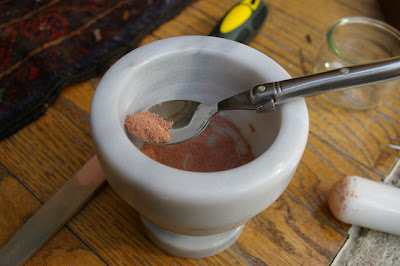Buoyed from the success of my first efforts, I have continued to work on creating more pigments from scratch. My goal is to have hand-made historic pigments to match or replace everything I currently use on my palette. The only important requirement is that they should be permanent colors. I would like to avoid the highly toxic pigments.
Why not simply buy these colors? There is a niche industry that can still supply them. However, most historic pigments made today are also prepared using modern equipment. These pigments are extremely finely, uniformly ground. These colors lack the unique look and handling qualities of hand made paint.
I have reason to believe that natural hand-ground pigments are much of what made the Old Master's work special. Is it any coincidence that the great search for the "Secrets of the Old Masters" began about the same time modern synthetic tube paints appeared? I don't think so.
For example, people have been analyzing the work of Rembrandt now for over a century, trying to unlock his "magic." Efforts to recreate his style with modern materials fall flat. This has led to claims he employed special mediums, magic elixirs that allowed him to render in a way that is not possible today. Chemical analysis has never shown anything special, yet some continue to persist. I believe it a simple combination of genius and a mastery of the materials used.
Moving on from black, I approached the next set of "easy" colors, the natural earth pigments.

Some clay gathered from the back of our property. The iron minerals in the clay are what gives it its color. To make a pigment, I need to filter it and collect only the smallest particles of clay. I've worked out a method similar to what was done historically to prepare my own.

Some tools of the trade. My first order of business was to sift out organics and really coarse particles. Then I washed what was left over repeatedly with water, passing it between many jars quickly, to collect only the lightest, finest clay particles.
It probably sounds a lot more complicated than it was. The whole process only took about an hour.


I set aside the full jar for a couple hours. The fine silt settled to the bottom. Then I drained the water away, and can set the clay out to dry.

Here is some yellow clay I'm drying to make yellow ochre.

The clay after several days of drying.

I scraped it off and ground the final pigment.

The final color, mixed with oil. I've created a large chart to record all of my different pigments. This way I can also compare and reference the different earth colors as I make them.
















































